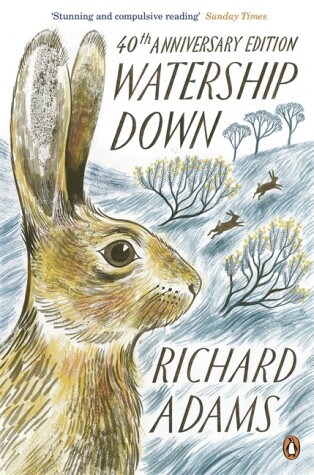
Amber (The Literary Phoenix)
All that made me chuckle, because re-reading it, it opened with a note from Adams about how Watership Down came about, and it was a story he was telling his daughters in the car. No deep political message intended, at least not at the get-go. Academia always amuses me like that, because we spend so much time in literature classes analyzing the deeper meaning of fiction that it often feels like we’re overthinking it.
Don’t get me wrong, the final version of Watership Down also contains conversation about hierarchies and survival and what not, but the fact that it was created with entertainment in mind strikes a chord. We often forget that books are out there for enjoying as well as discussion.
Digression aside – Watership Down. There were ups and downs to this book. I think I liked it well enough in high school – certainly enough that I don’t have harsh memories of hating it, which is something. Revisiting the book puts me solidly in the middle. There are moments that are interesting and I am invested in the rabbits’ story. There are moments where I found myself frustrated that things were just dragging along and it seemed the book should have been over by now. I have two major complaints about Watership Down for me as a reader, and the absolute first is the lack of an overall plot. One could certainly argue that setting up a new and thriving warren is the overall plot, but the way it is written is like a bumpy road with several small subplots that are solved in a linear matter. Getting away from the old warren, finding a home for the new one, farm raid, the Efrafa raid, and so on. Generally, though? This book dragged and dragged and dragged. I just read for it to be done and I’m not quite sure why it needed to be so long.
The format works really well for a story that is told in the oral tradition. You want the sort of thing that goes up and down in tension to be told over a multi-session period. It works much less well in a written book unless that book is a book of loosely connected short stories. But this one isn’t. So there.
As for its classification as classic children’s lit… whoever decided that is foolish. This book is violent. We’ve got one rabbit at Efrafa that is badly mutilated and put on display as a warning and that’s just a taste of the harshness. It doesn’t bother me, but as a book that is regularly taught to ‘tweens, it’s something to consider. Not that they couldn’t handle it, but it certainly depends on the person….
Considering that the book is more dialogue than description, the characters are mostly alright. I quite liked Pipkin and Blackberry. I thought Fiver was pretentious and Hazel selfish. You can get behind the characters for a little while, at least, but they’re not likable enough to dismiss the very slow and ambling tone of the story as a whole.
Watership Down is interesting because it’s different, but I’m not quite sure how it managed to reach this place of being a masterpiece and taught in school. I don’t mind animals as main characters, and I feel Richard Adams presented them fairly well – they felt like rabbits, not people, and I thought that was well done. I am glad I revisited Watership Down just on a the pretense of refreshing my memory, but this really isn’t the type of book I would excitedly recommend to most people or keep in my personal library, because I was bored. It was interesting and different enough that it’s the type of thing maybe I’d borrow and pick up every decade and a half… but I think even that’s a bit generous.



